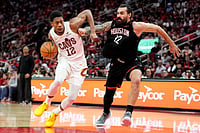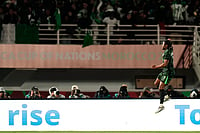The term 'naturalist' brings up images of field biologists like Salim Ali or John Muir, of people who spendyears studying and classifying the creatures of this world. Some biologists, however, choose to ignore thelarger picture in favour of studying particular examples of a species, focusing as much on individualpersonalities as species characteristics. For such scholars it seems appropriate to use the term 'animalanthropologist'. Think of Joy Adamson's books about Elsa the lioness, or Jane Goodall studying the chimps ofGombe. Elizabeth Marshall Thomas is another of this small clan.
These scholars generally write books about 'exotic' animals, whose very unfamiliarity makes them morefascinating for the reader. Likewise, Ms. Thomas has written about the wolves on Baffin Island, but the booksthat brought her into the public consciousness were about the animals closest to our lives -- household dogsand cats.
The Hidden Lives of Dogs, in 1993, with its combination of clear-eyed description and affectionateanthropological analysis, enchanted readers then and now with its stories of Maria and Misha, the huskies. Herlatest book, The Social Lives of Dogs, will immediately attract dog-lovers with its lovely drawings byJared Taylor Williams, and by its subtitle: The Grace of Canine Company.
The anthropologist in Thomas makes this more than just a description of her pets. The organisation ofher household is different from that of most dog-owners -- she chooses (and can afford) to live so that heranimals have as much freedom as possible. Her farm in New Hampshire has dog doors and the animals areencouraged to go in and out as they like, play in the woods on their own schedule, warm themselves by thefire, select their own beds, and most of all, develop their own hierarchy. Yet this closeness to the naturalstate is only partial, as the animals don't have to hunt their own food, are taken to the vet for regulartreatment, and are, in the end, reliant upon their human benefactors.
Thomas makes no bones about the incompleteness of their freedom. She tells the story of Sundog, a lovelywhite stray of astonishing cleverness, who 'fell in love' with Bean, a dog who belonged to a temporaryconstruction worker at their house. While the work was ongoing, Bean came every day with her owner and playedwith Sundog, but once it was completed, the two met no more, as Bean's owner took her off to the nextconstruction site. It is tempting to be amused at the dramatic terms in which this separation is described,but in fact, Sundog is very obviously sad as he waits each day for Bean, and brightens whenever they passBean's house. There is no romance-novel ending here -- Bean's owner does not want to give her to Thomas, andThomas has no intention of giving up Sundog, so the dogs are parted forever. She says with painful clarity:
Few dogs get to develop relationships with their loved ones. Dogs are slaves, born to do what we want, notwhat they want. Even on the rare occasions when we see with any clarity with our animals desire, our wisheshave high priority, theirs have low priority, and we convince ourselves, however wrongly, that we know what'sbest for them.
The book shines when Thomas simply watches the dogs' behaviour and describes it in meticulous detail. Mostdog-owners could give you a detailed description of their pets, and most of us also anthropomorphise them tovarious degrees. So does Thomas, but her observer's eye is unusually keen, and her writing is simple,evocative, and unforced:
Despite Pearl's many sensitivities, she was not sensitive about her own person. In this, she was less like aliving, breathing organism and more like a bowling ball. Indifferent to pain, and in fact to any hardship, shewould charge around recklessly whenever she got excited, squeezing through spaces too small for her body,knocking things down without noticing. Once [...] she tried to get through a cat flap in the screen door. Herhead went through, or part of it did, but the opening was much too small for the rest of her. But that wasn'timportant -- she went through anyway, oblivious to the ripping screen.
The farm household contained a fluid mix of four or more dogs, up to a dozen cats, several parrots, Thomas,her husband Steve, her mother, several companions who help to care for her mother, and assorted neighbours andfriends. They separated into several multi-species groups, each containing a dog and one or more cats. Threeof the groups contained a person. How these groups were formed and how they reflect the strict hierarchy amongthe animals is described in one of the most interesting sections of the book.
The evolutionary analyses are less successful. As an anthropologist Thomas spent several years among theBushmen of South Africa, and she suggests that the wild dogs who hang around the Bushmen camps are close tothe earliest dogs of Neolithic camps. This may well be so, but the intriguing observations are weakened by theless convincing speculations that follow. These wild dogs are not fed by the people, but they do not hunt.They rely on human-generated trash to survive, and each forages on its own, a desperate livelihood for anyanimal in the parched Kalahari desert. Thomas theorises that this independent hunting behaviour originatedbecause most Africans typically beat or stone the wild dogs. She does not explain why this behaviour, whichbarely allows survival, would be evolutionarily favoured over hunting alone or in packs like the dingo, afellow canine.
While Thomas lets the reader into parts of her personal life, there are occasional mysterious holes in theinformation provided. She makes it clear that she has a fondness for independent, typically crossbred, dogs,rather than purebreds who have been bred for beauty over strength of personality. Yet she buys her next dog, aBelgian sheepdog, from a breeder who keeps his dogs locked in crates except for two brief visits to a concreterun each day. The rationale for this choice of dog is never explained, but a cynic might wonder whether Thomassimply needed data to support her negative view of breeders and purebreds. Misty, the sheepdog, certainlyprovides this supporting data; she is deeply insecure and throughout her life remains a sad contrast to thecharming, clever Sundog.
In interviews, Thomas has been critical of naturalists who force their observations to fit a particularhypothesis. Yet she too is guilty of wishful logic on occasion. She describes a moment when she is thinking ofMisty's insecurity, and Misty wakes up, looks at her, and then races out to the backyard, all on her own, forthe first time. Thomas regards this almost mystically as an example of ESP. Readers may wonder, as I did, ifMisty had simply heard a squirrel outside.
This isn't a dog-training book. There are few insights into training, and for good reason: Thomas keeps hertraining to a minimum.
I don't give my dogs much training because I want them to do their own thinking, to do what they wantrather than wait to see what I want. If I train them, they learn from me. If I don't train them, I learn fromthem. So most of what they needed to know, they learned from other dogs, and they usually performed toperfection sooner or later.
In fact, the dogs often appear to train Thomas as much as the reverse. Pearl, the Aussie-chow mix, likes towake up early and barks loudly if Thomas does not get up too. Over the space of a few months, Pearl has Thomaswaking up earlier each day until they reach a compromise time of 4.30 each morning. Thomas says ruefully that'three cups of coffee and five hours of sleep are almost as good as eight hours of sleep, or they are for awhile, anyway.'
The household contains at least 8 cats and several parrots, but this book, as its title suggests, focuseson the dogs (who incidentally get along fine with the cats and sometimes form strong cross-species bonds). Theoccasional cat anecdotes are tempting enough that cat-lovers may want to look out for her earlier book TheTribe of the Tiger
Most people who are graced by the company of household pets will enjoy this book, and will agree withNapoleon that 'a dog teaches us a lesson in humanity'.























